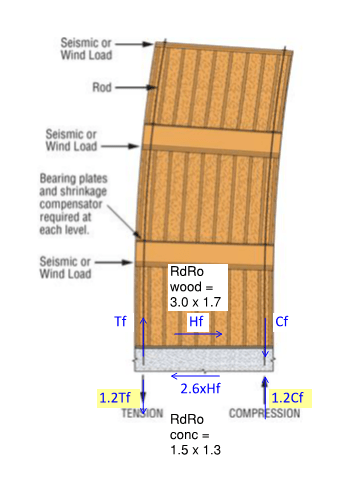I got a question. I am adapting ASCE 7's two-stage seismic analysis for the canadian code to design mid-rises. My first time doing a project like this where seismic governs.
According to ASCE 7, I understand I am suppose to scale up the reaction from wood to concrete by RdRo wood (3.0x1.7) / RdRo concrete (1.5x1.3) (Rd/rho in ASCE, RdRo in canadian code). However when it comes to the tension/compression caused by the hold-down, some have suggested to me that the tension/compression only need to be scaled up to the capacity of the ATS rod (e.g. 12~1.4) instead of ratio of RdRo wood / concrete (2.6). I suspect scaling up the Tf Cf by 2.6 would result in very uneconomical design that is not common practice.
I am curious to what others have done in this scenario. Much appreciated.

According to ASCE 7, I understand I am suppose to scale up the reaction from wood to concrete by RdRo wood (3.0x1.7) / RdRo concrete (1.5x1.3) (Rd/rho in ASCE, RdRo in canadian code). However when it comes to the tension/compression caused by the hold-down, some have suggested to me that the tension/compression only need to be scaled up to the capacity of the ATS rod (e.g. 12~1.4) instead of ratio of RdRo wood / concrete (2.6). I suspect scaling up the Tf Cf by 2.6 would result in very uneconomical design that is not common practice.
I am curious to what others have done in this scenario. Much appreciated.

